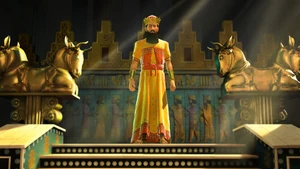by
Damien F. Mackey
“Through chiasmus, once again, it may tell us exactly who [Darius the Mede]
was by mirroring him with his alter ego monarch of a different name”.
This article has a parallel in my:
Toledôt Explains Abram’s Pharaoh
https://www.academia.edu/26239534/Toled%C3%B4t_Explains_Abrams_Pharaoh
{Toledôt and chiasmus, the keys to the structure of the Book of Genesis,
may lead us to a real name for this “Pharaoh”.}
In that article I was been able, with the benefit of the toledôt and chiastic structures of the Abrahamic histories, written (or owned) by Ishmael and Isaac,
“These are the generations of Ishmael …” (Genesis 25:12).
“These are the generations of Isaac …” (Genesis 25:19).
(a) to show that the two accounts of the abduction of Sarai/Sarah actually referred to just the one single incident, not two; and that
(b) he who is called “pharaoh” in the first account (Ishmael’s) was the same as the “Abimelech” referred to in the second account (Isaac’s).
Thus the Bible does apparently name Abram’s Pharaoh!
Now Ishmael, whose mother was Egyptian, writes his account from an Egyptian perspective; whereas Isaac, who dwelt in Palestine, writes from a more northerly perspective. This difference in perspective, yielding two rather different accounts of just the one incident, if not appreciated by commentators, can lead them to conclude, but wrongly, that these were two quite separate abductions (thereby increasing the pain for Sarah).
But, when the Abrahamic narratives are subjected to chiasmus, then it is found that “pharaoh” is perfectly mirrored by “Abimelech”.
The Bible, therefore, appears to be providing us with a key identification.
Although it does need to be noted that two names that intersect in a chiastic structure do not necessarily always identify each one named as being the same person.
Now to Darius the Mede.
Perhaps more important for commentators is the fact that the Book of Daniel provides the very same service in the case of the very enigmatic, but key, Darius the Mede. Through chiasmus, once again, it may tell us who he was by mirroring him with his alter ego monarch of a different name. See James B. Jordan’s brilliant chiastic structuring of Daniel 6 on p. 314 of
The Handwriting on the Wall
| Hence, as many have suspected (e.g. George R. Law, Identification of Darius The Mede: |
http://readyscribepress.com/home_files/DtM-Daniel_5_30-31.pdf.), Darius the Mede is the same as Cyrus the Persian.
The Bible seems to point it out for us.
Now, the Apocrypha provides a further confirmation of this identification with another account of Daniel in the lions’ den. Here Darius the Mede is presented as Cyrus. This again, like with the abduction of Sarai/Sarah, is a case of the same story being told by two different authors, quite differently. But it is nevertheless about the one same incident. All of the main protagonists are there in both accounts. Biblical scholars ought easily to be able to reconcile the two with sufficient care and attention to detail.
Just as God would assure that his beloved Sarah was never going to be abducted twice, so would he assure that his beloved Daniel had only once to endure the den of lions.

